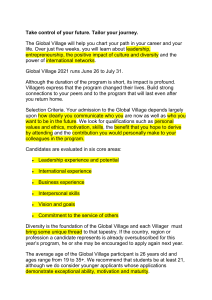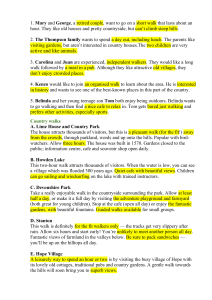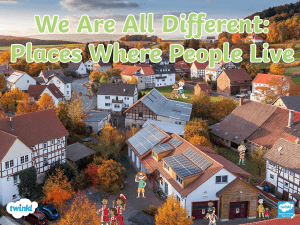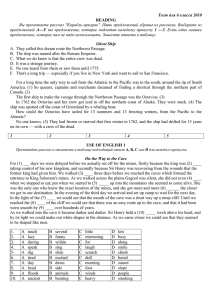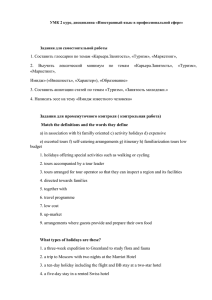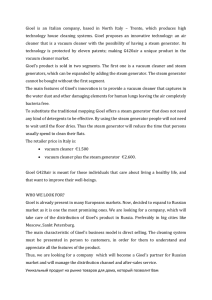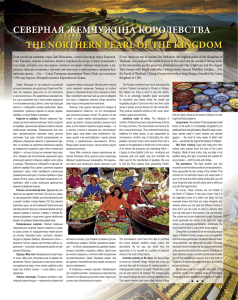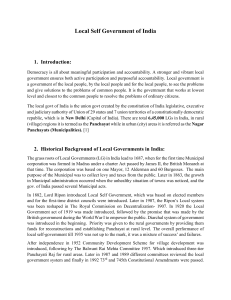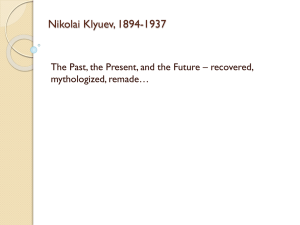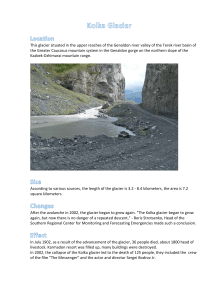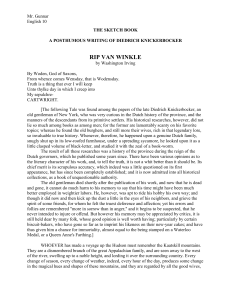Tuokslahti
реклама
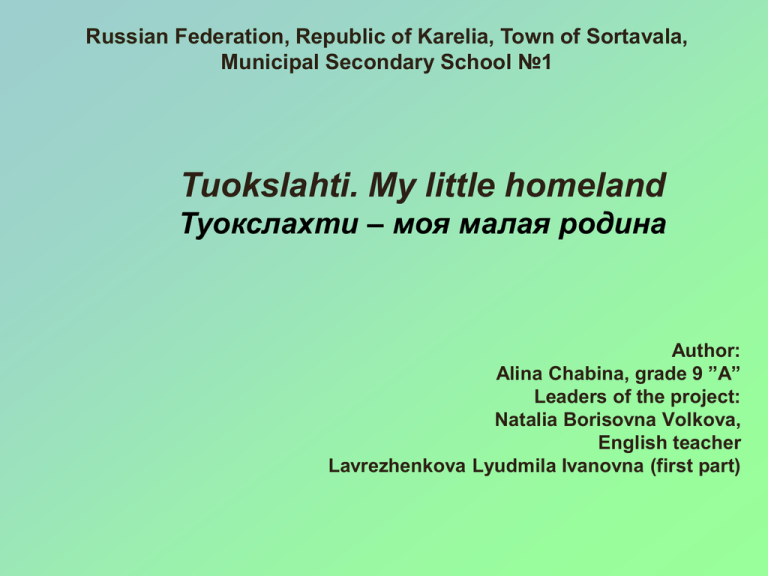
Russian Federation, Republic of Karelia, Town of Sortavala, Municipal Secondary School №1 Tuokslahti. My little homeland Туокслахти – моя малая родина Author: Alina Chabina, grade 9 ”A” Leaders of the project: Natalia Borisovna Volkova, English teacher Lavrezhenkova Lyudmila Ivanovna (first part) Tuokslahti is my little homeland Туокслахти – моя малая родина The aims of this work are: - to preserve our history and culture for future generation; - to create a guidebook about Tuokslahti. The subjects of this work are: • to study some materials about history of Tuokslahti; • to summarize materials from different sources; • to give a description of remained objects and buildings, take their photos; • to describe natural sights of the village; • to analyse the material and to find out the characteristic features of nature, culture, history, economic of my homeland; • to think of some rational ideas about possible using of the sights of the village. Methods: • working with the references, materials of the regional Museum of Northern Ladoga, topographical maps of the Finnish period, newspaper articles; • talking to the local residents; • walking around the surroundings; • taking photographs; • creating a guide. Tuokslahti Sortavala Tuokslahti village is located 10 km away on the highway to the west of Sortavala. Деревня Туокслахти расположена в 10км по шоссейной дороге на запад от .Сортавала. 1 6 2 3 4 Guide map: 1 – The birth of the village 2 – Tuokslahti - fragrant bay 3 –Walking through the village center 4 – Stone Kingdom 5 – The Estate "Karhatsu" 6 – What do we have as a heritage? 5 Tuokslahti - "fragrant gulf " Kivivuori - stone mountain, covered with forests Hotinlahti - Gulf in the shape of small fish Kiteenjoki - rushing river "The house of mistres." «Дом госпожи» The building of the elementary school, which was opened in 1898 Здание народной школы, которая открыта в 1898 году Surrounding mountains Rouvanmyaki Окрестности горы Роуванмяки lake Hotinlahti Озеро Хотинлахти pine forest Сосновый бор The school was a cultural center Школа - культурный центр Local residents at the meeting in public schools, 1890 Местные жители на собрании в народной школе, 1890 г. Favorite place for rest of the local residents Любимое место отдыха местных жителей Порог Туокскоски с высотой 3 метра и протяженностью 25 метров Kiteenjoki river with mountain character Река Китенйоки с горным характером 3 meter high and 25 meter long Tuokskoski threshold The ruins of the mill on the river Kiteenjoki Остатки мельницы на реке Китенйоки Flour was made from wheat, rye, barley and oats, which were grown in the fields of local landowners. Pearling on River Kiteenjoki Добыча жемчуга на реке Китенйоки Pearls of Kitenyoki were light with the size of a "sugar pea." They were secretly sold to Olonets Китенйокские жемчужины были светлыми величиной с «сахарную горошину». Их тайно продавали в Олонец The central part of the village - Tiaysenmyaki Центральная часть деревни - Тиайсенмяки There is a beautiful view on an agricultural landscape, Haaposenmyaki mountain, river Kiteenjoki, gentle slopes with scattered old Finnish houses on them from the mountain Tiaysenmyaki This building had a bakery where delicious buns and pretzels were baked В этом здании располагалась пекарня, в которой пекли вкусные булочки и кренделя This house belonged to the family of a wealthy landowner Ryattu. It is built of brick, with large windows and had high basement Этот дом принадлежал семье богатого землевладельца Рятту. Он построен из кирпича, имеет большие окна, высокий подвал Old Finnish well built of stone Старый финский колодец построен из природного камня Дома промышленных рабочих – пример жилых домов конца 19 начала 20 вв. The houses of industrial workers are an example of houses of the late 19th and early 20th centuries. Plan of the house План жилого дома "Stone steps" «Каменные ступеньки» Mountain Haaposenmyaki with the Quarry A block of stone in the foundation of the house with traces of drilling Гора Хаапосенмяки с каменоломнями Каменный блок в фундаменте дома со следами от бурения Mountain Tavonmyaki is an object with mining value Гора Тавонмяки – объект горнодобывающего значения it has three peaks, next to each other, it is 25 meters high Mutton foreheads – the traces of the glacier Имеет три вершины, расположенные друг за другом Высота горы 25 метров Бараньи лбы – следы от ледника Dark gray block of plagiogranites with traces of drilling Блок темно-серого плагиогранита со следами от бура Mound from narrow-gauge railway Насыпь от узкоколейной железной дороги Farmyard of estate "Karhatsu" Скотный двор усадьбы «Кархатсу» Businessman Kale Nissinen donated a lot of money on the development of the village Stable Конюшня Remains of water drinkers Room for keeping cows Помещение для содержания коров Следы от водяных поилок The Second floor of the farmyard Второй этаж скотного двора Architectural elements of farmyard Архитектурные элементы скотного двора Agricultural landscape with fields and meadows are the effects of farming in the North Ladoga What do we have as heritage? Что оставлено в наследство? landowner Nissinen Paper factory was built on the money of patrons in 1907. The factory produced 35004000 tons of printed paper a year Judge Carl Berg The walls, outbuildings of the factory are well preserved to the present days До наших дней от фабрики хорошо сохранились стены, хозяйственные постройки Millstone was used as the press for the production of paper Жернов использовался как пресс для получения бумаги The place for pulp Бункер для древесной массы Niemiskoski threshold Порог Ниемискоски Hydroelectric power station in Pitkyakoski was built in 1914 Действующая гидростанция в Питкякоски. Построена в 1914 году Scheme of Kiteenjoki River near hydroelectric stations Схема реки Китенйоки в районе гидростанции Outlet, which is closed with metal spokes Пропускное отверстие, закрытое металлическими спицами The three-meter dam that maintains water pressure Трехметровая плотина, которая поддерживает напор воды Окрестности гидростанции зимой и весной Surroundings of hydroelectric station in the winter and spring Conclusion: 1. Tuokslahti village is a settlement with a rich history, culture and economy There are natural, industrial and agricultural facilities. 2. It was the village, that improved the methods of farming, using natural resources for construction, helped the development of culture. 3. The settlement played the great role in the development of the forestry and wood industry, agriculture and mining in the late 19th and first half of the 20th century in the Northern Ladoga. 4. The village is of great interest as a tourist destination.
